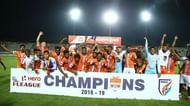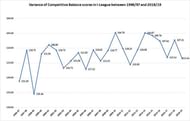The long-term sustainability of a sports league, in terms of retaining the interest of fans and generating income from the games, depends on the competitive balance of the league in the world of sports. Sport is subjected to variable quality, which might have implications in its competitive balance or anti-competitive behaviour. Unlike other strands of the entertainment industry, sport depends upon inconsistency and uncertainty for success.
The top division of the Indian Football League System until 2018-19, also known as the I-League (previously known as National Football League until 2007), is ranked 20th in the AFC Club Competitions and is currently into its 24th season since being incepted in 1996-97. Unlike some of the top leagues in the world, the I-League is contested between 10 to 12 teams playing each other home and away on a round-robin system and has a cap of 4 foreign players (players without an Indian Passport) on each team.
However, there has been lack of uniformity in terms of the total number of teams participating in the league as it has ranged from as low as 6 teams in 1998-99 to as high as 14 teams in 2009-10. In the year 2014, Football Sports and Development Limited (FSDL), a consortium formed by IMG and Reliance launched the Indian Super League (ISL) with 8 teams or franchisee representing 8 cities, mirroring the Major League Soccer (MLS) in USA (ISL, 2013).
While the number of teams in ISL increased from 8 to 10 in the 2017-18 season, confusions and conflict emerged with both I-League and ISL claiming themselves as the top tier of Indian Football, and AFC finally proposing a roadmap to merge teams from both leagues in 2024-25.

Competitive balance can be defined as the balance between teams competing in a tournament in terms of uncertainty in final result which is driven by revenues made by the league's participating clubs such as the revenues generated by the ticket office, stadium operations, sponsorships and the broadcasting rights. The origins of competitive balance lies in the professional US leagues, where sharing the revenue is a way to maintain balance among teams. The concept was formulated by Michael Rottenberg in 1956 and it has played a major role in shaping the modern-day literature around modern-day sports economics.
In successful sports leagues, teams are equally balanced leading to uncertainty in outcomes as there has been an inherent interest from league members to maintain the health of their rivals. There are two possible behavioural assumptions about professional teams: clubs are supposed to maximize either their profits, mirroring the reality of US professional leagues or the number of seasonal wins, capturing the situation of European team sports.
Competitive Balance was measured using the industry-wide measure, Herfindahl Index of Competitive Balance (HICB) and CB score percentages. The optimal HICB score a league can assume is 100. As the HICB score increases, competitive balance declines. On the other hand, the highest value a CB score percentage can assume is 100, which means the league is perfectly competitive.
As the CB score percentage reduces, competitive balance improves. HICB scores for I-League between 1996-97 and 2018-19 were analysed and a statistically significant time-trend was observed. It has been found out that the overall competitive balance in the top division of Indian football has improved significantly in 23 seasons. A statistically significant improvement was also observed when CB score percentages were analysed.

It has also been identified that the increase in number of teams in I-League had a positive effect on the overall HICB scores, leading to significant improvement. I-League enjoyed it's most competitive season in 2010-11, when there were 14 teams in the league and recorded a HICB score of 104.79 and a CB score percentage of 75.68. A recent research by Dr Daniel Plumley, Harry Preston, Dr. Girish Ramchandani and Dr. Rob Wilson from Sheffield Hallam University tried to analyse the optimum number of teams required to achieve a competitively balanced league and found the number between 10 and 19. On the basis of the findings, we can say that the number of teams in the I-League is in the optimum range.
Ever since the introduction of ISL, the I-League has enjoyed better competitive balance in 4 of the 6 seasons than the top 5 football leagues in Asia, which are the Qatar Stars League, Chinese Super League, Persian Gulf Pro League, UAE Pro League and K-League. These scores make it difficult to answer whether there is a correlation between the two leagues, as significant research needs to be undertaken to analyse the same.
Any debate around the structure of sports leagues centres around sporting competition and integrity and despite the debate regarding the relevance of competitive balance, it remains no doubt in our minds that CB is an important component of modern-day sport and sport economics.
